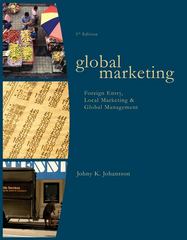Question
PROBLEM 2: CAPACITY AS A STRATEGIC BARRIER TO ENTRY You are asked to analyze a sequential game illustrating the strategic role of capacity. The goal
PROBLEM 2: CAPACITY AS A STRATEGIC BARRIER TO ENTRY You are asked to analyze a sequential game illustrating the strategic role of capacity. The goal is to have a game theoretic understanding of how excess capacity can limit entry in an industry, that is, how the incumbent can build an endogenous barrier to entry.
THE PROBLEM Consider an industry whose demand is given by: p = 900 q1 q2, where, as usual, p is the market price, q1 is the output of firm 1 and q2 is the output of firm 2. To enter the industry a company must build a production facility. Capacity is typically lumpy. This is captured by allowing the firms to build one out of two possible facilities: small facility, large facility. A small facility costs $50,000 and it allows the firm to produce as many as 100 units at (for sake of simplicity) zero marginal cost. Alternatively, the firm can pay $175,000 to construct a large facility that will allow the firm to produce as many as 700 units at zero marginal cost.
You are asked to analyze two games:
SIMULTANEOUS GAME The firms decide secretly and simultaneously the facility to construct and then, given the capacities, they decide secretly and simultaneously the output to produce. Given the resulting total output, the market price is determined by the industry (inverse) demand. The goal of both firms is to maximize their profits. Find the Nash equilibrium of such a game. Compute prices and profits. [Hint: Note that firms choose both capacity and output to maximize profits. So proceed in two steps. First solve the simultaneous games where firms with given capacities choose output to maximize profits. (There are 4 cases to consider.) Then, using this, write down the payoff matrix for the simultaneous game where firms choose capacities to maximize profits, and solve for the Nash equilibrium.]
SEQUENTIAL GAME Firm 1 moves first. It must decide whether to construct a small or a large facility. Then firm 2, after having observed the facility built by firm 1, decides whether to enter the industry or not, and, if it enters the industry, what facility to construct. Finally, after having observed the facilities built, both firms secretly and simultaneously decide the output levels. The goal of both firms is to maximize their profits. Analyze this game. Find the credible Nash equilibrium. Does the existence of a potential competitor affect the decision taken by the first firm? (That is, if potential competitor firm 2 did not exist, would firm 1 choose the same size of facility as when this potential competitor exists?)
Step by Step Solution
There are 3 Steps involved in it
Step: 1

Get Instant Access to Expert-Tailored Solutions
See step-by-step solutions with expert insights and AI powered tools for academic success
Step: 2

Step: 3

Ace Your Homework with AI
Get the answers you need in no time with our AI-driven, step-by-step assistance
Get Started


